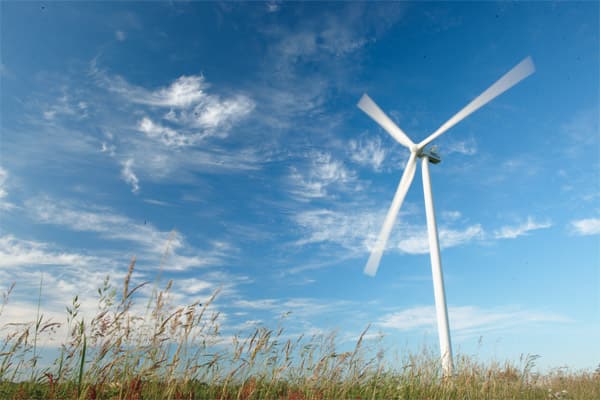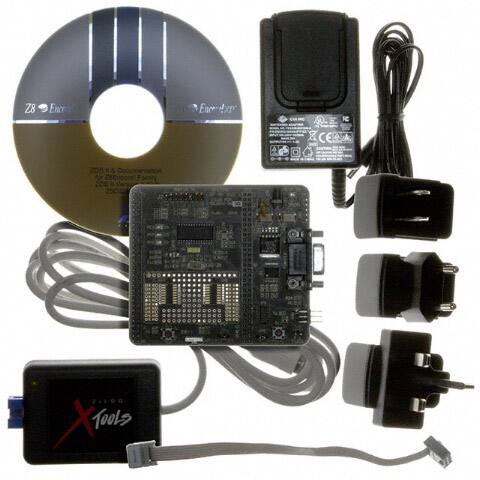Wind Energy Harvesting
投稿人:电子产品
2012-07-11
Wind power has been recognized as a viable source of “free” energy for hundreds of years. Since it pre-dates the petroleum economy or even the industrial revolution, it seems odd to refer to it as an “alternative” energy source. Wind turbines have been a significant player as a renewable energy source since the early 1980s. Wind power covers a wide range of applications and can be harnessed by large wind turbine farms providing up to 800 MW of power, and small residential wind turbines providing 3 kW to a home.
Broadly speaking, wind energy conversion systems can be classified into variable-speed and fixed-speed devices. Variable-speed systems employ an electronic interface for grid connection. Fixed-speed systems commonly use squirrel cage induction generators which are directly connected to the grid.
The first turbines were constant-speed designs with very little control or optimization. In simplified terms, the generator would remain offline until the wind reached a minimum operational velocity. Once this minimum wind speed created sufficient blade rotational speed, the generator would be switched on, thereby joining the power grid. From that point the so-called infinite bus effect would provide speed control for the generator due to the overwhelming difference between the one rotating mass of the wind turbine compared to that of the rotating machines supplying energy to the electrical grid.
Vertical-axis wind turbines (VAWTs) are a type of wind turbine where the main rotor shaft is set vertically and the main components are located at the base of the turbine. Among the advantages of this arrangement are that generators and gearboxes can be placed close to the ground, which makes these components easier to service and repair, and that VAWTs do not need to be pointed into the wind as they accept wind input from a full 360 degrees.
On the other hand, the horizontal axis design (Figure 1) needs to be properly aligned in order to capture the greatest amount of energy. Fortunately, turning in the direction of the wind (weathercocking) is a naturally occurring phenomenon, so it’s not that difficult--for smaller designs that is. For the massive turbines used in utility-scale wind farms, yaw control is added with motors and gears to orient the blades perpendicularly to the wind direction.
Since all grid-connected commercial wind turbines today are built with a propeller-type rotor on a horizontal axis (i.e., a horizontal main shaft), for the rest of the discussion let us assume a horizontal-axis design.

Figure 1: Typical three-bladed horizontal axis wind turbine (Courtesy of Vestas).
Successful harvesting depends on the two basic variables of wind direction and speed. Compensation for wind speed can be difficult. Fixed-blade systems are aerodynamically designed to stall in certain conditions, so as to prevent overspeed and mechanical failure in high winds. When the wind speed becomes too high, it creates turbulence on the side of the rotor blade which is not facing the wind. This stall prevents the lifting force of the rotor blade from acting on the rotor. If you look closely at a rotor blade for a stall controlled wind turbine, you will notice that the blade is twisted slightly as you move along its longitudinal axis. This is partly done in order to ensure that the rotor blade stalls gradually rather than abruptly when the wind speed reaches its critical value.
A more flexible and popular design employs variable-pitch blades where the rotor blades have to be able to turn around their longitudinal axis (to pitch). On a pitch controlled wind turbine, the turbine's electronic controller checks the power output of the turbine several times per second. When the power output becomes too high, it sends an order to the blade pitch mechanism, which immediately pitches (turns) the rotor blades slightly out of the wind. Conversely, the blades are turned back into the wind whenever the wind drops again.
Pitch correction not only provides a mechanism for preventing the blades from spinning too fast, but also allows the blade pitch or angle of attack to be matched to a wider range of wind speed in order to maximize power production.
Wind turbines with variable-speed operation can harvest energy from a wider range of conditions. As wind speeds go from the lower regime (say, 10 to 15 mph), the rotor can rotate at a low speed and provide correspondingly low, but useful, levels of power. As wind speed picks up, the rotor can eventually reach the full speed for rated power output. At that point, the pitch control will be operated to maintain the rotor speed as close as possible to full power.
Converting to electrical energy
The wind turbine generator converts mechanical energy to electrical energy. Wind turbine generators are a bit unusual, compared to other generating units you ordinarily find attached to the electrical grid, in that the generator has to work with a power source (the wind turbine rotor) which supplies fluctuating mechanical power (torque).
Even though wind turbine systems vary in rated output from a few hundred watts to megawatts, historically most wind electric generators have been attached to asynchronous loads. The three most obvious methods of providing asynchronous electricity are the DC generator, the AC generator, and the self-excited induction generator. For the large wind farm application, designs have migrated to asynchronous rotating machines, also known as induction machines – motors or generators. There are many distinct advantages to the asynchronous approach for the wind turbine mainly due to the absence of control over the energy input.
The asynchronous machine can be called either a motor or a generator since the design is the same, and it is simply the speed of the rotor that determines operational mode. Below the synchronous speed of the grid to which the machine is connected, it will consume power. Above synchronous speed, the machine will provide an output power that the grid can deliver to a load.
The induction machine is common from fractional horsepower designs to very large generators in wind farms. The advantage most often cited is that induction generators are easiest on turbine gearboxes. The common induction motor (for smaller units) is usually the squirrel-cage rotor design, while large wind turbines employ the wound rotor also known as the doubly-fed generator since there are external connections to both the stator and rotor. They are used in the largest share of designs currently operating. The squirrel-cage rotor machines also require less maintenance since there are no contact brushes for external connection to the rotor.
For megawatt class machines, the induction machine is preferred. An alternative approach is to use a permanent magnet generator, but these have been considered too costly for very large machines due to the cost of the magnetic material. On the other hand, these designs reduce maintenance associated with rotating contacts while offering improved efficiency and removing the need for starting capacitor banks. These generators are synchronous and are often called PMAs — short for “permanent magnet alternators.”
They also have become extremely popular for small wind-harvesting systems — especially home-built versions. For this type of grassroots energy production, the permanent magnet rotor design is competing with the ubiquitous induction motors available in a broad range of power ratings.
Just as the DC output of solar cells is unregulated, the AC coming from wind turbines is not regulated, since it depends on the wind, which is not a constant. The AC from the turbines varies both in frequency and in voltage, so without modification it is essentially unusable. The typical approach is to take the turbine output, rectify it and feed it to a DC-AC inverter. In many instances, the output of the inverter will need to be converted again for charging batteries or powering electronic equipment. Taking into account that today’s inverters can produce a high-voltage, fixed-frequency output that can be 97 percent efficient, this multiple conversion method can make sense.
Wind inverters are an integral part of the wind power system that converts electricity generated by the turbine to be compatible with the electric power grid. Wind turbine power generation depends on the speed of the wind and the resulting rotational speed of the turbine. While solar inverters use the Maximum Power Point Tracking algorithm to maximize harvested power, the wind inverter must be provided the maximum power characteristic curve which is unique for each wind turbine model. The ability to harvest energy at very low wind speeds comes from wind inverters that have a low threshold of Vin to generate Vac.
Power-One’s Aurora Wind inverters use an optimized power curve algorithm to increase the amount of energy that can be harvested from wind turbines. The company’s larger scale wind inverters are designed to work in parallel to support large wind turbines (up to 10 MW) at a very high (98.7 percent) efficiency. For small wind applications, Power-One offers AURORA wind inverters ranging from 3 W to 12.5 W with corresponding Wind Interface units. For community scale wind systems, Power-One has developed a modular inverter design that allows the system to continue harvesting energy in case of a single module failure.
Electronic components
The electronic components required in a wind harvesting system can be broadly categorized into the following areas:
- Sensing
- Power conditioning
- Control
- Excitation
For battery charging, a full wave rectifier will be part of a more efficient charging circuit. High power units like the Microsemi VJ247M Controlled Avalanche Bridge Rectifier is specified to 200 V peak reverse voltage and 10 A forward current.
Although smaller turbines require less monitoring and have fewer control inputs, there are some basic needs for charge control and monitoring that are common to any wind harvesting system. Furthermore, the benefits of intelligent control for monitoring and algorithms tailored for the best maximum power point tracking and other improvements have been recognized even for kilowatt class designs.
Zilog has a line of microcontrollers designed for these types of control applications. The Zilog Z16FMC is available in an inexpensive development kit (Figure 2) to allow investigations into generator control for wind energy harvesting systems.

Figure 2: Zilog Z16FMC Series flash microcontroller series development kit (Courtesy of Zilog).
From our discussion of controls for large wind turbines, it’s easy to see that there is a long list of potential measurement inputs, computation, and control outputs to optimize operation of the system. The large wind harvesting turbine needs to fit into a grid system in the least disruptive way with an unpredictable energy input. Furthermore, safety is not to be taken lightly considering the massive size of blades and the kinetic energy of the rotation even in modest winds. Strain, vibration, and temperature need to be monitored at various points.
Even for systems with known and controlled energy inputs, intelligent system control is useful for the power plant for safety and to ensure efficient operation. For the wind energy plant, as with most energy harvesting applications, performance is enhanced via monitoring and control to allow tracking of the maximum energy output. With enormous spinning blades, system monitoring is crucial. Beyond mechanical safety, the designer must consider the complexities of start-up and load dumping and the potentially very high voltage spikes as magnetic fields collapse in the large inductive windings of the generator.
免责声明:各个作者和/或论坛参与者在本网站发表的观点、看法和意见不代表 DigiKey 的观点、看法和意见,也不代表 DigiKey 官方政策。






 中国
中国